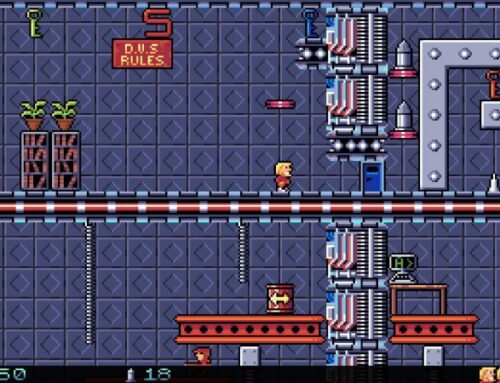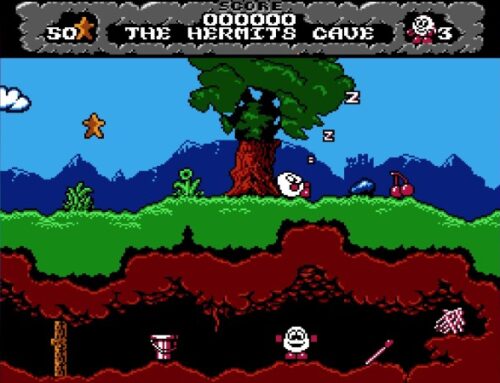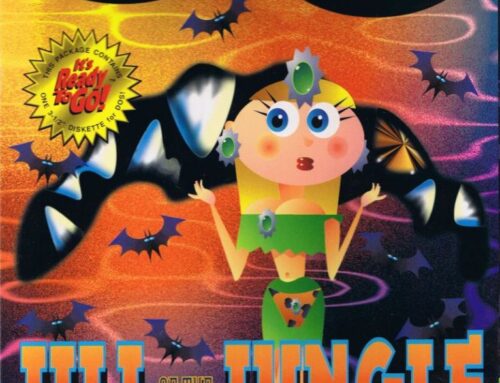
In this occasional series, we’ll be taking a look at some classic retro platform games. But not just any old platform games — the classic “platforms and ladders” games that typified the 8-bit home computer market in the 1980s!
The “platform game” is one of those genres that has expanded to a ridiculous degree over the years. So broad is the term now that games which are completely unrecognisable from one another technically occupy the same genre so far as typical classification goes.
In Platforms and Ladders, we’ll be specifically focusing on a particular type of platform game: that seen on the 8-bit home microcomputers of the ’80s. Even there, though, we have a variety of different subtypes — and thus that means there are plenty of interesting games to explore, compare and contrast with one another!

We begin our exploration with Dynamite Dan for the ZX Spectrum, first released in 1985 through Mirrorsoft and subsequently ported to Amstrad CPC, Commodore 64 and MSX. As a release from the mid-’80s, this eschews the single-screen gameplay of titles from a few years prior in favour of a more open-structure formula: similarly to Matthew Smith’s classic Jet Set Willy, to which the game was often compared favourably by the press of the period, Dynamite Dan tasks you with exploring an open map in pursuit of several key items in order to beat the game.
Dynamite Dan is no straight Jet Set Willy clone, mind you, and that should be immediately clear just from looking at it. For starters, we’ve got much larger, more detailed sprites, and an environment that looks and feels much more realistic than Jet Set Willy’s abstract tile-based map. The trade-off for this enhanced graphical detail is, of course, that Dynamite Dan’s overall map size of 6 screens by 8 is a tad smaller than Jet Set Willy’s irregularly shaped 60-room map — but that’s not necessarily a bad thing.
Your goal in Dynamite Dan is to locate eight sticks of dynamite that are placed in random locations around the game map each time you play. Once you have them all, you are to use the dynamite to blow open the evil Dr. Blitzen’s safe, avoid the unwanted attentions of his assistant Donner (Donner und Blitzen, geddit?), steal the bad Doktor’s plans for a death ray and finally make it back to the start point and escape in an airship.

Naturally, this is easier said than done, because being a ZX Spectrum platform game, Dynamite Dan is absolutely bastard hard. It knows it’s absolutely bastard hard, though, because you’re provided with a very generous stock of lives to begin the game with, plus carking it either at the hands of an enemy or by falling too far doesn’t require you to restart the screen you’re on. Not only do you pick up right where you lost your last life, but if you were killed by an enemy, that enemy disappears. In this way, you have a certain amount of flexibility to tactically remove certain obstacles.
There’s no need to “damage boost” your way through the whole game in this way, though; inexplicably, collecting a can of deodorant makes Dan temporarily invincible, allowing him to simply obliterate enemies without penalty while the screen border flashes a variety of colours in a distinctly seizure-inducing fashion. Consequently, knowing where to find the deodorant and how best to use it becomes an integral part of succeeding at Dynamite Dan.
Like other open-structure “collect all the items in a big house” games for the Spectrum, Dynamite Dan is non-linear. Right from the very beginning of the game you can go in either direction, and you’ll discover before long that the map is actually “cylindrical” — keep going long enough in one horizontal direction and you’ll end up right back where you started. In many cases it’s helpful to understand how best to approach certain locations from multiple angles, since the all-important dynamite and other helpful items are often found in extremely inconvenient locations!

As with many platformers of the era, Dynamite Dan might initially appear to be insurmountably difficult — but spend a bit of time with it and you’ll discover it’s a game that rewards repeated engagement over the long term. You’ll get to know the map better, you’ll come to understand the enemy patterns better, and you’ll know the best way to deal with various obstacles — such as knowing exactly when to collect the aforementioned deodorant.
Due to the randomised element, Dynamite Dan never becomes a simple test of memorisation and executing actions by rote, but there’s a definite benefit to learning the game piece by piece. Ultimately your goal should be the ability to see a piece of dynamite sitting anywhere in the game map and know exactly how to reach it relatively easily and safely — it’ll take you a while to get there, but it absolutely is possible!
If you’re easily frustrated by the deliberately stiff controls and accuracy demanded by classic ZX Spectrum platformers, Dynamite Dan probably won’t do much to change your mind. But if you’re open to that very distinct sort of experience, Dynamite Dan is very much a game worth spending some time with — because as annoying as it can be at times, it’s hard to deny that there’s something absolutely magical about it that keeps you coming back for just one more try time and time again!
Dynamite Dan is archived over at World of Spectrum, or you can play it online at the Internet Archive.




